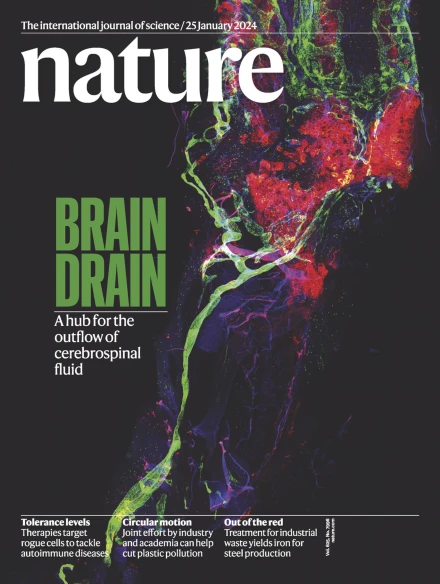跨越发育、成年和疾病过程的人脑血管单细胞图谱。
IF 50.5
1区 综合性期刊
Q1 MULTIDISCIPLINARY SCIENCES
引用次数: 0
摘要
广泛的脑部病变严重依赖于血管,而脑血管疾病是导致全球死亡的主要原因。在这里,我们对来自 68 名人类胎儿和成年患者的 117 份样本中的 606380 个新鲜分离的内皮细胞、血管周围细胞和其他组织衍生细胞进行了单细胞 RNA 测序分析,从而构建了发育中的胎儿、成人对照组和患病人类脑血管的分子图谱。我们发现了健康胎儿和成人大脑血管的广泛分子异质性,以及五种依赖血管的中枢神经系统(CNS)病变,包括脑肿瘤和脑血管畸形。我们在病变血管中发现了动静脉分化的改变、重新激活的胎儿以及保守的失调基因和通路。病理内皮细胞显示出中枢神经系统特异性的丧失,并显示出 MHC II 类分子的上调,这表明中枢神经系统内皮细胞具有非典型特征。细胞-细胞相互作用分析预测了大量内皮细胞-血管周围细胞配体-受体交叉作用,包括免疫相关和血管生成途径,从而揭示了内皮细胞在脑神经血管单元信号网络中的核心作用。我们的单细胞脑图谱提供了对发育中、成人/对照组和患病人类脑血管的分子结构和异质性的深入了解,可作为未来研究的有力参考。本文章由计算机程序翻译,如有差异,请以英文原文为准。


Single-cell atlas of the human brain vasculature across development, adulthood and disease
A broad range of brain pathologies critically relies on the vasculature, and cerebrovascular disease is a leading cause of death worldwide. However, the cellular and molecular architecture of the human brain vasculature remains incompletely understood1. Here we performed single-cell RNA sequencing analysis of 606,380 freshly isolated endothelial cells, perivascular cells and other tissue-derived cells from 117 samples, from 68 human fetuses and adult patients to construct a molecular atlas of the developing fetal, adult control and diseased human brain vasculature. We identify extensive molecular heterogeneity of the vasculature of healthy fetal and adult human brains and across five vascular-dependent central nervous system (CNS) pathologies, including brain tumours and brain vascular malformations. We identify alteration of arteriovenous differentiation and reactivated fetal as well as conserved dysregulated genes and pathways in the diseased vasculature. Pathological endothelial cells display a loss of CNS-specific properties and reveal an upregulation of MHC class II molecules, indicating atypical features of CNS endothelial cells. Cell–cell interaction analyses predict substantial endothelial-to-perivascular cell ligand–receptor cross-talk, including immune-related and angiogenic pathways, thereby revealing a central role for the endothelium within brain neurovascular unit signalling networks. Our single-cell brain atlas provides insights into the molecular architecture and heterogeneity of the developing, adult/control and diseased human brain vasculature and serves as a powerful reference for future studies. Endothelial cells from vascular-dependent central nervous system (CNS) diseases reveal reactivated fetal pathways, display common hallmarks of disease — including a partial loss of arteriovenous specification and CNS-specific properties as well as an upregulation of MHC class II receptors — and play a key role in the human brain neurovascular unit across development, adulthood and disease.
求助全文
通过发布文献求助,成功后即可免费获取论文全文。
去求助
来源期刊

Nature
综合性期刊-综合性期刊
CiteScore
90.00
自引率
1.20%
发文量
3652
审稿时长
3 months
期刊介绍:
Nature is a prestigious international journal that publishes peer-reviewed research in various scientific and technological fields. The selection of articles is based on criteria such as originality, importance, interdisciplinary relevance, timeliness, accessibility, elegance, and surprising conclusions. In addition to showcasing significant scientific advances, Nature delivers rapid, authoritative, insightful news, and interpretation of current and upcoming trends impacting science, scientists, and the broader public. The journal serves a dual purpose: firstly, to promptly share noteworthy scientific advances and foster discussions among scientists, and secondly, to ensure the swift dissemination of scientific results globally, emphasizing their significance for knowledge, culture, and daily life.
 求助内容:
求助内容: 应助结果提醒方式:
应助结果提醒方式:


